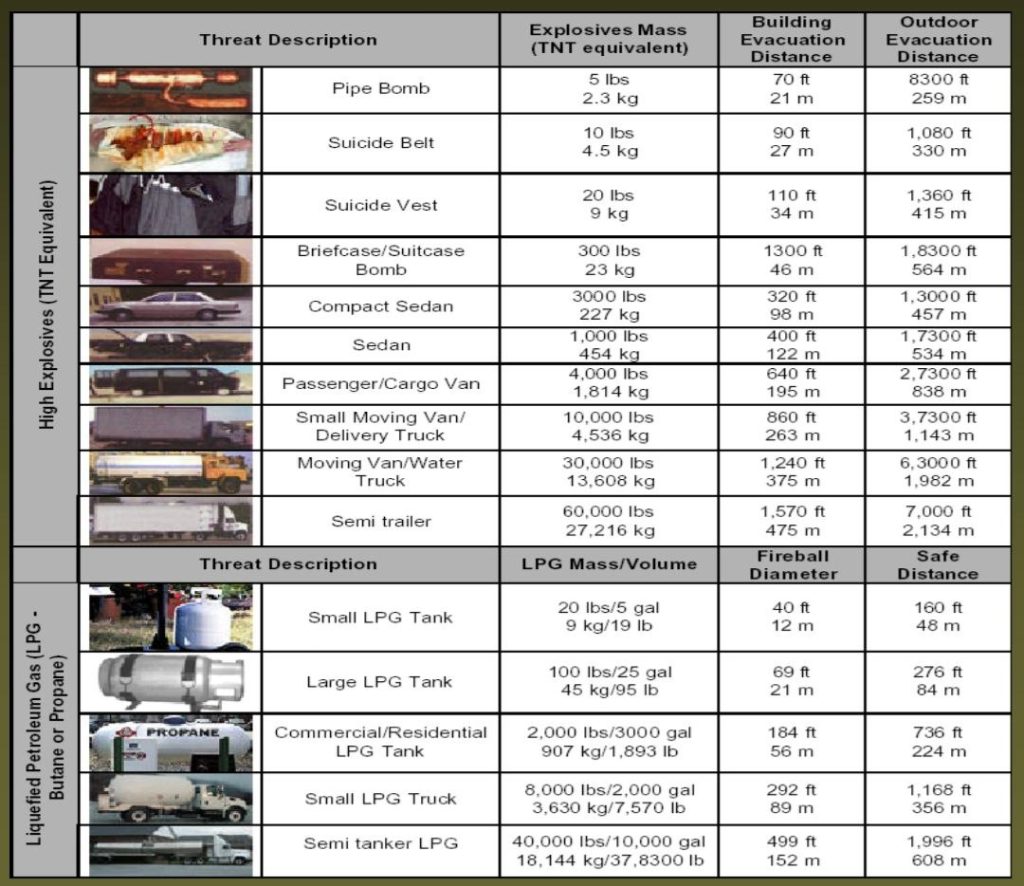Increase survivability in an explosion occurring in close proximity by taking a few reactionary measures.
These tactics are similar regardless of the type of blast. Industrial complexes or tanker trunks offer inherent risks such as flawed equipment, leaks, human error, or other negligence that could lead to an unintended explosion. Additionally, the threat of Improvised Explosive Devices (IEDs) and terroristic bombings should also be a cause for concern.
Here’s what to do if you suspect a Person Borne, Vehicular Borne (PBIED or VBIED) or stationary IED.
For the purposes of this guide, we are focused on ground threats and not airborne attacks. Our goal here is to provide techniques and procedures for surviving and not necessarily stopping the threat. These are standoff reactions. We’re not saying you should not attempt to stop the threat but rather focus this brief on the option to avoid and survive rather than to attack and survive.
What to Do to Survive an Explosive Device
Focus
》Do not focus on the IED. It’s not going to move, but other threats may be nearby. Scan the area, and look for hostile actors and your egress. Do focus on vehicles or persons that may be carrying an IED. Egress from them while watching for their movements and collecting observables to assist in after-action investigations.
Move
》Move away from the threat. Warn those around you. Take cover behind a metal or stone structure or inside a building on the ground floor. If you are in a vehicle where an IED is detected, speed up past the threat or stop short and reverse.
》Safe distance for an IED/PBIED is 100ft when a structure/cover separates you from the threat or 1,300ft when there is none. Safe distance for a VBIED is 800ft when a structure/cover separates you from the threat or 2,700ft when there is none.
》Stay low, look for a natural depression in the ground (ditch) or find a step-down.
Survive Secondary Effects
Prioritize
》 If you have direct cover from the direction of the blast, your first goal is to defend from the concussive effect and falling debris from a collapsed structure or tertiary shrapnel.
》If you do not have direct cover from the direction of the blast, your first goal is to defend from the initial shrapnel, concussive effect, and falling debris from a collapsed structure or tertiary shrapnel.
Concussive Force
》To lessen the effects of the concussive force, you should first face away from the IED, then cover ears and eyes while keeping your mouth open. The best way to accomplish this is by placing your thumbs in your ear holes and your hands over your eye sockets. Depending on the force your eyes could be pushed out of their sockets. This is the reason for hands on eyes but it also shields from debris.
A shockwave of high-pressure ripples from the source of the explosion outward until space or distance negates the wave to normal atmospheric pressure.
We open our mouths in order to equalize compression from the sudden change in pressure and avoid lung collapse. We cover ears to delay the force traveling from ears, through eustachian tubes, to lungs. Those tubes going into your throat need to fill with pressure before your eardrums get the full force to lessen the blow. The goal of the “mouth-open, thumbs in ears, hands-on eyes” (MO-TE-HE) is to equalize/distribute positive pressure, negative pressure, and the return to normal pressure.
Debris and Shrapnel
》Finally, you’ll need to shield your intestines/organs and head. Most experts teach to lay face down (or on your knees facing down) while covering your head. However, this exposes your back which provides an easy entry point for shrapnel/falling debris to puncture your skin and damage internal organs.
Depending on the direction of the threat (initial shrapnel or tertiary building collapse debris), lay on your back in a fetal-like position where your knees are tucked to your stomach and your arms/elbows are shielding your chest/head, (this position can be achieved while MO-TE-HE).
Conclusion
In short; egress, get to cover, MO-TE-HE, assume a safe position, brace. Afterward, be wary of secondary explosions or attacks. Call for help, get to safety, render aid.
This article was originally written by the Grayman Briefing. Stay in the know, sign up for Intel and Situational Awareness alerts pushed to your phone on emerging threats and preparedness warnings. Click HERE to subscribe to the Grayman Briefing.
=====
Become a Survival Dispatch Insider …
We bring together survival enthusiasts and preppers to share skills and knowledge, so you can enhance your preparedness for emergencies and ensure the safety of you and your community.
The Results You’ll Get …
Our community, courses, and memberships are pretty special. We’re focused on the ways it will make a huge difference in your life.
Here are a few of the things you’ll be able to do as a member of Survival Dispatch Insider …
1) Improve your emergency preparedness by learning survival skills and strategies from experienced preppers.
2) Build lasting connections with like-minded individuals that share your passion for safety and readiness.
3) Access a wealth of knowledge and resources to assist in protecting you and your community during unexpected situations.
Click HERE to get started.
=====

